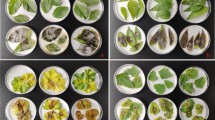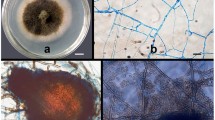Abstract
Camellia leaves were most effective for recoveringPhytophthora cinnamomi from soils followed by azalea leaves and cedar needles. A total of 131 isolates ofP. cinnamomi was obtained from soils and roots collected in Shanghai. Among them 125 were A1 and 6 were A2 type. There was little variation in morphological and physiological characteristics among 82 isolates tested. It is suggested that the fungus may have been a recent settler in Shanghai.
Similar content being viewed by others
References
Zentmyer GA.Phytophthora cinnamomi and the disease it causes. Am Phytopathol Soc (St. Paul), 1980.
Zentmyer GA. Origin and distribution of four species ofPhytophthora. Trans Brit Mycol Soc 1988; 91: 367–378.
Ko WH. Hormonal heterothallism and homothallism inPhytophthora. Ann Rev Phytopathol 1988; 26: 57–73.
Arentz F, Simpson IA. Distribution ofPhytophthora cinnamomi in Papua New Guinea and notes on its origin. Trans Brit Mycol Sco 1986; 87: 289–295.
Zentmyer GA. Distribution of the A1 mating type ofPhytophthora cinnamomi. Phytopathology 1976; 66: 701–703.
Ko WH. Sexuality, evolution and origin ofPhytophthora. Plant Prot Bull 1980, 22: 141–151.
Ko WH, Chang HS, Su HJ. Isolates ofPhytophthora cinnamomi from Taiwan and evidence for an Asian origin of the species. Trans Br Mycol Soc 1978; 71: 496–499.
Ho HH, Zhuang WY, Liang ZR, Yu YN.Phytophthora cinnamomi on black locust (Robinia pseudoacacia) in Jiangsu Province of China. Mycologia 1983; 75: 881–886.
Zheng XB, Lu JY. studies onPhytophthora species in Fujian, Zhejiang, Jiangsu Provinces and Shanghai, China. Acta Mycol Sinica 1989; 8: 161–168.
Shew HD, Bensen DM. Qualitative and quantitative soil assays forPhytophthora cinnamomi. Phytopathology 1982; 72: 1029–1032.
Tsao PH, Guy SO. Inhibition ofMortierella andPythium in aPhytophthora-isolation media containing hymexazol. Phytopathology 1977; 67: 796–801.
Ann PJ, Ko WH. Variants ofPhytophthora cinnamomi extended the known limits of the species. Mycologia 1985; 77: 946–950.
Chen DW, Zentmyer GA. Production of sporangia byPhytophthora cinnamomi in axenic culture. Mycologia 1970; 62: 397–402.
Shanghai Dictionary Editorial Committee. A Dictionary of China 1988.
Author information
Authors and Affiliations
Rights and permissions
About this article
Cite this article
Zhou, X.G., Zhu, Z.Y., Lu, C.P. et al. Phytophthora cinnamomi in Shanghai and its possible origin. Mycopathologia 120, 29–32 (1992). https://doi.org/10.1007/BF00578499
Received:
Accepted:
Issue Date:
DOI: https://doi.org/10.1007/BF00578499




